Carnauba Wax and Beeswax as Structuring Agents for Water-in-Oleogel Emulsions without Added Emulsifiers
Abstract
1. Introduction
2. Materials and Methods
2.1. Materials
2.2. Methods
2.2.1. Contact Angle Measurements
2.2.2. Critical Gelling Concentration (CGC)
2.2.3. Lab-Scale Emulsion Preparation
2.2.4. Pilot-Scale Emulsion Preparation
2.2.5. Stability Index
2.2.6. Rheology
2.2.7. PLM
2.2.8. Confocal Laser Scanning Microscopy Visualization (CLSM)
2.2.9. Cryo-SEM
2.2.10. Statistical Analysis and Data Processing
3. Results and Discussion
- Preliminary studies were aimed at reducing the number of experiments. Water–wax interactions were quantified by means of contact angle measurements. Two waxes were selected, and CGC was used to determine the relevant wax concentrations.
- Lab-scale experiments were used to assess the viability of the emulsions prepared using an Ultraturrax on a lab scale.
- Pilot-scale experiments aimed to assess the scaling-up potential of the W/O emulsions. Here, the most promising system was prepared using a pilot-scale SSHE and further evaluated.
- Microstructural analyses were performed in order to understand the fat crystal spatial distribution and the underlying interactions between the wax oleogels and water.
3.1. Preliminary Experiments
3.2. Lab-Scale Experiments
- One emulsion with wax concentrations well below the CGC,
- One emulsion with wax concentrations well above the CGC,
- One emulsion with the exact amount required for gelling the oil phase.
3.3. Pilot-Scale Experiments
3.4. Microstructural Studies
4. Conclusions
Supplementary Materials
Author Contributions
Funding
Data Availability Statement
Acknowledgments
Conflicts of Interest
References
- Berton-Carabin, C.C.; Schroen, K. Pickering Emulsions for Food Applications: Background, Trends, and Challenges. Annu. Rev. Food Sci. Technol. 2015, 6, 263–297. [Google Scholar] [CrossRef]
- Binks, B.P.; Horozov, T.S. (Eds.) Colloidal Particles at Liquid Interfaces; Cambridge University Press: Cambridge, UK, 2006. [Google Scholar]
- Van Bockstaele, F.; Romanus, M.; Penagos, I.A.; Dewettinck, K. Functionality of Natural Waxes in Hybrid Fat Crystal Networks. In Development of Trans-Free Lipid Systems and their Use in Food Products; Toro-Vazquez, J.F., Ed.; The Royal Society of Chemistry: London, UK, 2022. [Google Scholar]
- Doan, C.D.; To, C.M.; De Vrieze, M.; Lynen, F.; Danthine, S.; Brown, A.; Dewettinck, K.; Patel, A.R. Chemical profiling of the major components in natural waxes to elucidate their role in liquid oil structuring. Food Chem. 2017, 214, 717–725. [Google Scholar] [CrossRef]
- Blake, A.I.; Toro-Vazquez, J.F.; Hwang, H.-S. Wax Oleogels. In Edible Oleogels; AOCS Press: Urbana, IL, USA, 2018; pp. 133–171. [Google Scholar]
- Wang, D.D.; Li, Y.; Chiuve, S.E.; Stampfer, M.J.; Manson, J.E.; Rimm, E.B.; Willett, W.C.; Hu, F.B. Association of Specific Dietary Fats with Total and Cause-Specific Mortality. JAMA Intern. Med. 2016, 176, 1134–1145. [Google Scholar] [CrossRef] [PubMed]
- da Silva, T.L.T.; Arellano, D.B.; Martini, S. Use of High-Intensity Ultrasound to Change the Physical Properties of Oleogels and Emulsion Gels. J. Am. Oil Chem. Soc. 2019, 96, 681–691. [Google Scholar] [CrossRef]
- da Silva, T.L.T.; Chaves, K.F.; Fernandes, G.D.; Rodrigues, J.B.; Bolini, H.M.A.; Arellano, D.B. Sensory and Technological Evaluation of Margarines with Reduced Saturated Fatty Acid Contents Using Oleogel Technology. J. Am. Oil Chem. Soc. 2018, 95, 673–685. [Google Scholar] [CrossRef]
- García-González, D.O.; Yánez-Soto, B.; Dibildox-Alvarado, E.; Ornelas-Paz, J.d.J.; Pérez-Martínez, J.D. The effect of interfacial interactions on the rheology of water in oil emulsions oleogelled by candelilla wax and saturated triacylglycerols. LWT 2021, 146, 111405. [Google Scholar] [CrossRef]
- Hwang, H.-S.; Singh, M.; Bakota, E.L.; Winkler-Moser, J.K.; Kim, S.; Liu, S.X. Margarine from Organogels of Plant Wax and Soybean Oil. J. Am. Oil Chem. Soc. 2013, 90, 1705–1712. [Google Scholar] [CrossRef]
- Hwang, H.S.; Winkler-Moser, J.K. Properties of margarines prepared from soybean oil oleogels with mixtures of candelilla wax and beeswax. J. Food. Sci. 2020, 85, 3293–3302. [Google Scholar] [CrossRef] [PubMed]
- Merchan Sandoval, J.; Carelli, A.; Palla, C.; Baumler, E. Preparation and characterization of oleogel emulsions: A comparative study between the use of recovered and commercial sunflower waxes as structuring agent. J. Food Sci. 2020, 85, 2866–2878. [Google Scholar] [CrossRef] [PubMed]
- Öğütcü, M.; Arifoğlu, N.; Yılmaz, E. Preparation and Characterization of Virgin Olive Oil-Beeswax Oleogel Emulsion Products. J. Am. Oil Chem. Soc. 2015, 92, 459–471. [Google Scholar] [CrossRef]
- Wijarnprecha, K.; de Vries, A.; Santiwattana, P.; Sonwai, S.; Rousseau, D. Microstructure and rheology of oleogel-stabilized water-in-oil emulsions containing crystal-stabilized droplets as active fillers. LWT 2019, 115, 108058. [Google Scholar] [CrossRef]
- Wijarnprecha, K.; de Vries, A.; Santiwattana, P.; Sonwai, S.; Rousseau, D. Rheology and structure of oleogelled water-in-oil emulsions containing dispersed aqueous droplets as inactive fillers. LWT 2019, 115, 108067. [Google Scholar] [CrossRef]
- Binks, B.P.; Rocher, A. Effects of temperature on water-in-oil emulsions stabilised solely by wax microparticles. J. Colloid Interface Sci. 2009, 335, 94–104. [Google Scholar] [CrossRef] [PubMed]
- Gao, Y.; Lei, Y.; Wu, Y.; Liang, H.; Li, J.; Pei, Y.; Li, Y.; Li, B.; Luo, X.; Liu, S. Beeswax: A potential self-emulsifying agent for the construction of thermal-sensitive food W/O emulsion. Food Chem. 2021, 349, 129203. [Google Scholar] [CrossRef]
- Patel, A.R.; Schatteman, D.; De Vos, W.H.; Lesaffer, A.; Dewettinck, K. Preparation and rheological characterization of shellac oleogels and oleogel-based emulsions. J. Colloid Interface Sci. 2013, 411, 114–121. [Google Scholar] [CrossRef]
- Szumała, P.; Luty, N. Effect of different crystalline structures on W/O and O/W/O wax emulsion stability. Colloids Surf. A Physicochem. Eng. Asp. 2016, 499, 131–140. [Google Scholar] [CrossRef]
- Doan, C.D.; Van de Walle, D.; Dewettinck, K.; Patel, A.R. Evaluating the Oil-Gelling Properties of Natural Waxes in Rice Bran Oil: Rheological, Thermal, and Microstructural Study. J. Am. Oil Chem. Soc. 2015, 92, 801–811. [Google Scholar] [CrossRef]
- Hodge, S.M.; Rousseau, D. Flocculation and coalescence in water-in-oil emulsions stabilized by paraffin wax crystals. Food Res. Int. 2003, 36, 695–702. [Google Scholar] [CrossRef]
- Nguyen, V.; Rimaux, T.; Truong, V.; Dewettinck, K.; Van Bockstaele, F. The effect of cooling on crystallization and physico-chemical properties of puff pastry shortening made of palm oil and anhydrous milk fat blends. J. Food Eng. 2021, 291, 110245. [Google Scholar] [CrossRef]
- Ghosh, S.; Pradhan, M.; Patel, T.; Haj-shafiei, S.; Rousseau, D. Long-term stability of crystal-stabilized water-in-oil emulsions. J. Colloid Interface Sci. 2015, 460, 247–257. [Google Scholar] [CrossRef]
- Martins, A.J.; Cerqueira, M.A.; Fasolin, L.H.; Cunha, R.L.; Vicente, A.A. Beeswax organogels: Influence of gelator concentration and oil type in the gelation process. Food Res. Int. 2016, 84, 170–179. [Google Scholar] [CrossRef]
- Han, W.; Chai, X.; Liu, Y.; Xu, Y.; Tan, C.P. Crystal network structure and stability of beeswax-based oleogels with different polyunsaturated fatty acid oils. Food Chem. 2022, 381, 131745. [Google Scholar] [CrossRef]
- Thakur, D.; Singh, A.; Prabhakar, P.K.; Meghwal, M.; Upadhyay, A. Optimization and characterization of soybean oil-carnauba wax oleogel. LWT 2022, 157, 113108. [Google Scholar] [CrossRef]
- Borriello, A.; Masi, P.; Cavella, S. Novel pumpkin seed oil-based oleogels: Development and physical characterization. LWT 2021, 152, 112165. [Google Scholar] [CrossRef]
- Nadeem, H.; Vigil, R.D.; Samuel, A.; Sarkar, A.; Yeoh, T.; Olsen, M.G. Coalescence-induced phase separation of an oil in water emulsion under controlled shear and temperature conditions. Chem. Eng. Res. Des. 2022, 182, 517–524. [Google Scholar] [CrossRef]
- Barnes, H.A. Rheology of Emulsions—A Review. Colloid Surf. A 1994, 91, 89–95. [Google Scholar] [CrossRef]
- Rousseau, D. Aqueous droplets as active fillers in oil-continuous emulsions. Curr. Opin. Food Sci. 2020, 33, 173–186. [Google Scholar] [CrossRef]
- Visintin, R.F.G.; Lockhart, T.P.; Lapasin, R.; D’Antona, P. Structure of waxy crude oil emulsion gels. J. Non-Newton. Fluid Mech. 2008, 149, 34–39. [Google Scholar] [CrossRef]
- Ghosh, S.; Rousseau, D. Fat crystals and water-in-oil emulsion stability. Curr. Opin. Colloid Interface Sci. 2011, 16, 421–431. [Google Scholar] [CrossRef]
- Öğütcü, M.; Arifoğlu, N.; Yılmaz, E. Storage stability of cod liver oil organogels formed with beeswax and carnauba wax. Int. J. Food Sci. Technol. 2015, 50, 404–412. [Google Scholar] [CrossRef]
- Blake, A.I.; Marangoni, A.G. Plant wax crystals display platelet-like morphology. Food Struct. 2015, 3, 30–34. [Google Scholar] [CrossRef]
- Hwang, H.-S.; Kim, S.; Evans, K.O.; Koga, C.; Lee, Y. Morphology and networks of sunflower wax crystals in soybean oil organogel. Food Struct. 2015, 5, 10–20. [Google Scholar] [CrossRef]
- Alvarez-Mitre, F.M.; Toro-Vázquez, J.F.; Moscosa-Santillán, M. Shear rate and cooling modeling for the study of candelilla wax organogels’ rheological properties. J. Food Eng. 2013, 119, 611–618. [Google Scholar] [CrossRef]
- Blake, A.I.; Marangoni, A.G. The Effect of Shear on the Microstructure and Oil Binding Capacity of Wax Crystal Networks. Food Biophys. 2015, 10, 403–415. [Google Scholar] [CrossRef]

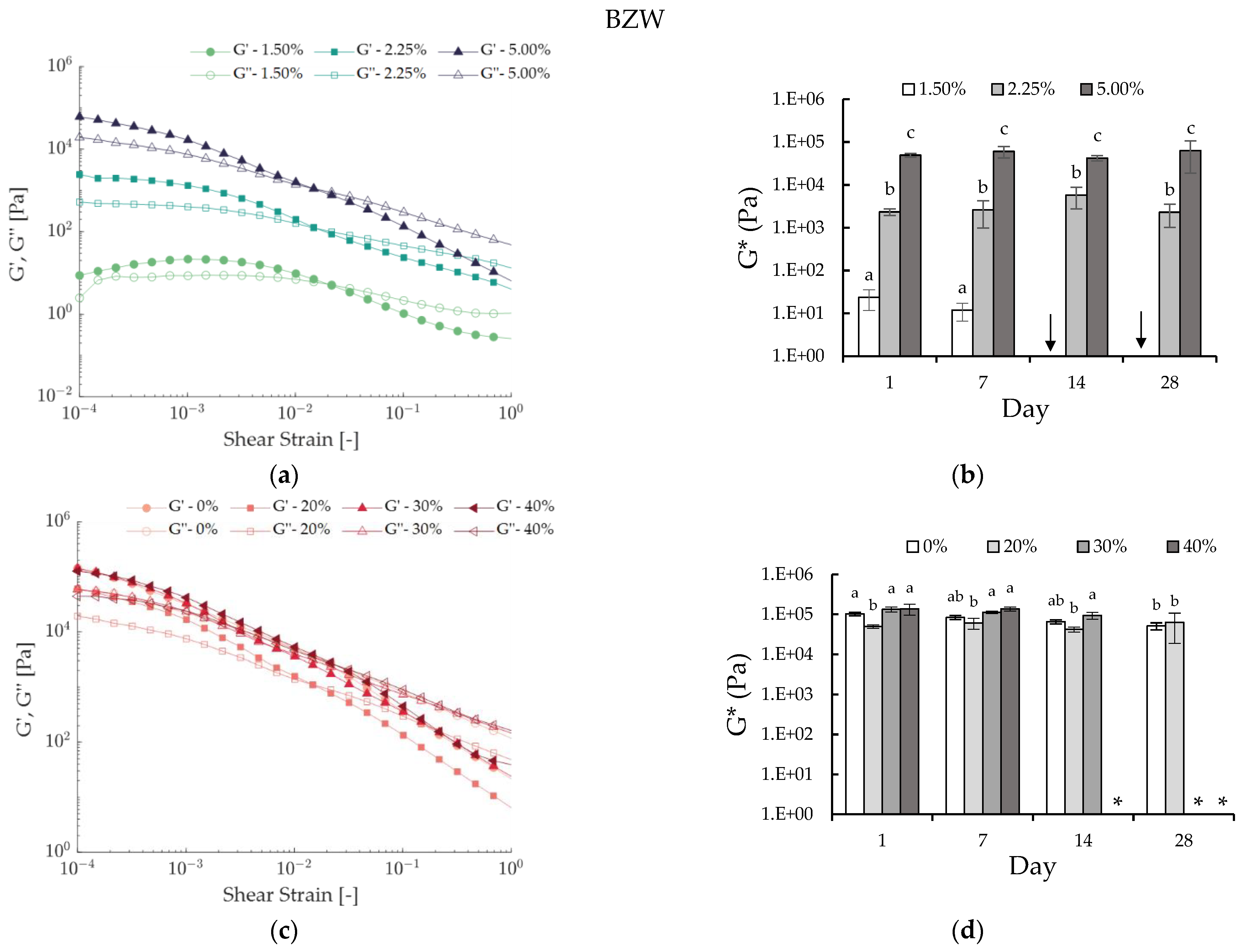
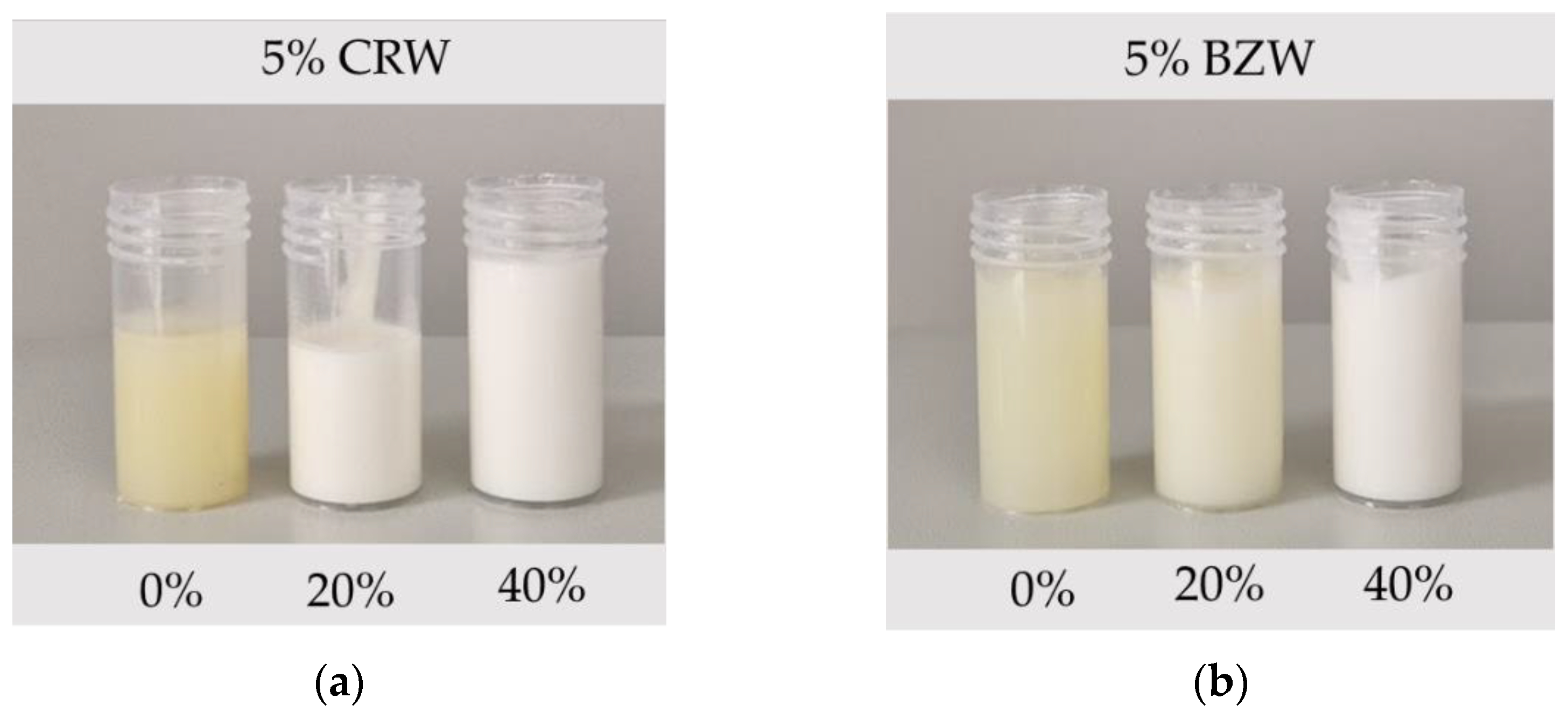
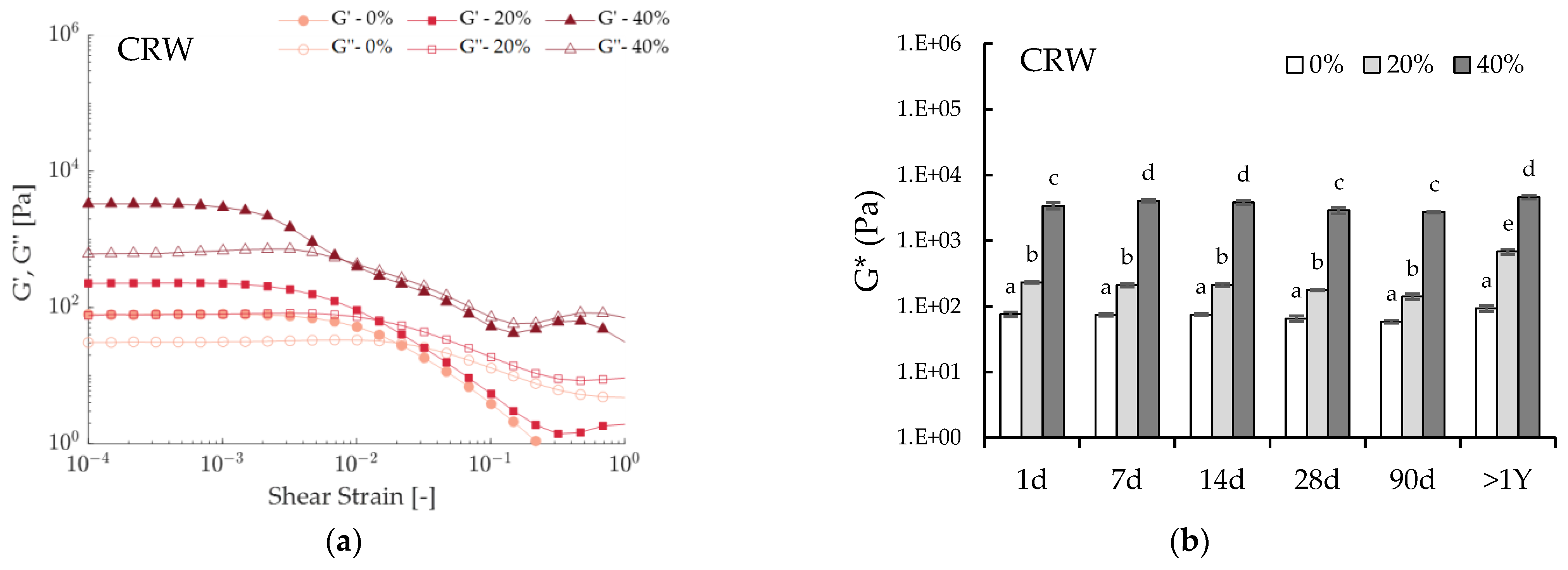




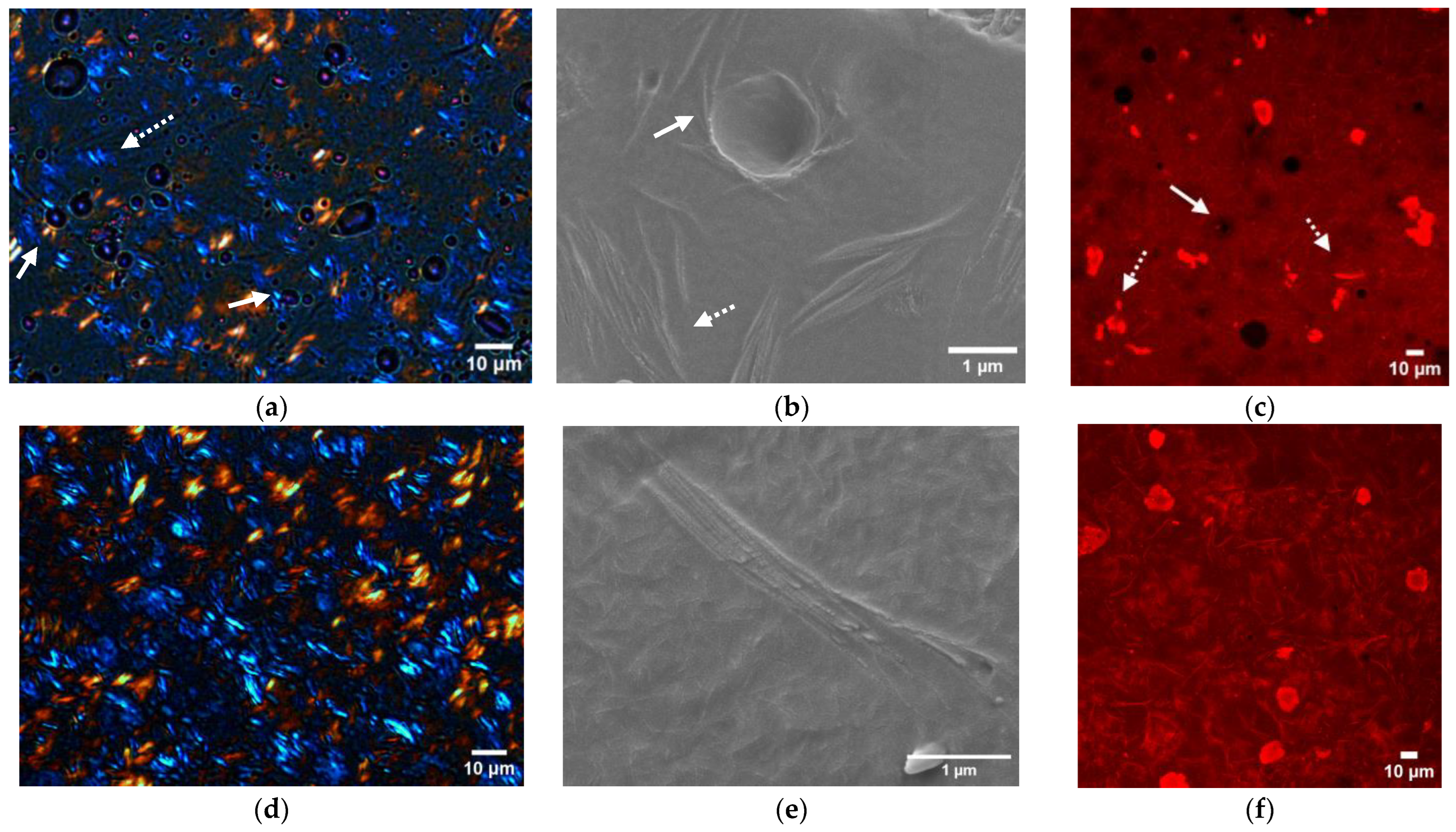
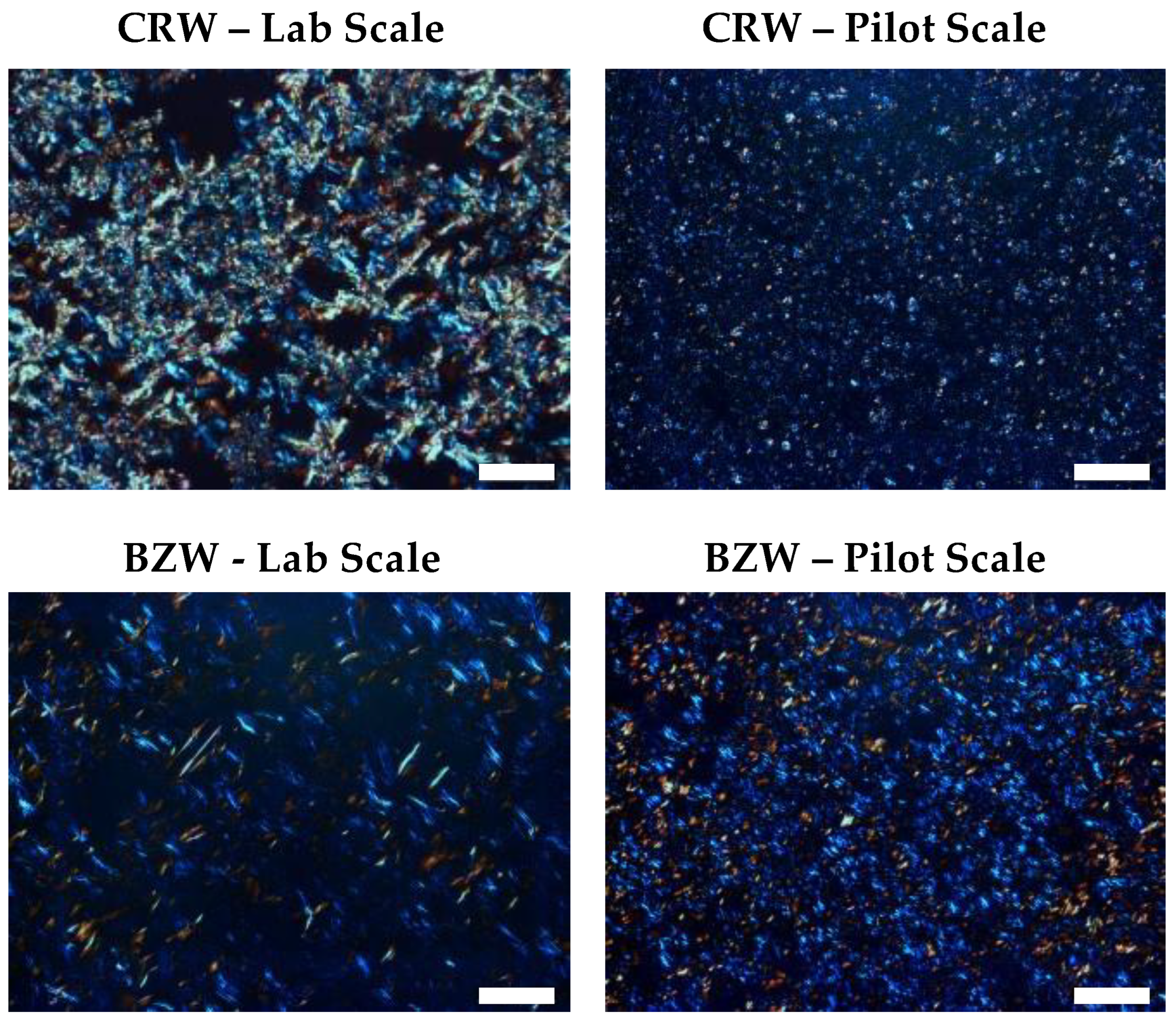
| Preparation Method | Wax | Water Concentration (w/w%) | Wax Concentration (w/w% Oil Phase) |
|---|---|---|---|
| Lab Scale | CRW | 0 | 5.00 |
| 20 | 2.50 | ||
| 5.00 | |||
| 7.50 | |||
| 30 | 5.00 | ||
| 40 | 5.00 | ||
| BZW | 0 | 5.00 | |
| 20 | 0.75 | ||
| 1.50 | |||
| 2.25 | |||
| 5.00 | |||
| 30 | 5.00 | ||
| 40 | 5.00 | ||
| Pilot Scale | CRW | 0 | 5.00 |
| 20 | |||
| 40 | |||
| BZW | 0 | ||
| 20 | |||
| 40 |
| Wax | Contact Angle Measurement (°) | CGC (%w/w) |
|---|---|---|
| CLW | 107.08 ± 1.87 | Not measured |
| BEW | 105.65 ± 2.56 | Not measured |
| RBW | 103.93 ± 1.19 | Not measured |
| SFW | 88.05 ± 1.88 | Not measured |
| CRW | 87.87 ± 1.15 | 5.0 |
| BZW | 83.57 ± 3.38 | 1.5 |
| Wax | Water Concentration (w/w%) | Wax Concentration (w/w% Oil Phase) | Time (Days) | |||
|---|---|---|---|---|---|---|
| 1 | 7 | 14 | 30 | |||
| CRW | 20% | 2.50 (=50% CGC) | 100.0% | 100.0% | 100.0% | 100.0% |
| 5.00 (=100% CGC) | 100.0% | 100.0% | 100.0% | 100.0% | ||
| 7.50 (=150% CGC) | 100.0% | 100.0% | 100.0% | 100.0% | ||
| 30% | 5.00 (=100% CGC) | 100.0% | 100.0% | 100.0% | 100.0% | |
| 40% | 5.00 (=100% CGC) | 100.0% | 100.0% | 100.0% | 100.0% | |
| BZW | 20% | 0.75 (=50% CGC) | 100.0% | 99.3% * | 96.2% * | 95.9% * |
| 1.50 (=100% CGC) | 100.0% | 100.0% | 98.2% * | 96.7% * | ||
| 2.25 (=150% CGC) | 100.0% | 100.0% | 100.0% | 100.0% | ||
| 5.00 (=333% CGC) | 100.0% | 100.0% | 100.0% | 100.0% | ||
| 30% | 5.00 (=333% CGC) | 100.0% | 100.0% | 100.0% | 100.0% | |
| 40% | 5.00 (=333% CGC) | 100.0% | 100.0% | 100.0% | 100.0% | |
Disclaimer/Publisher’s Note: The statements, opinions and data contained in all publications are solely those of the individual author(s) and contributor(s) and not of MDPI and/or the editor(s). MDPI and/or the editor(s) disclaim responsibility for any injury to people or property resulting from any ideas, methods, instructions or products referred to in the content. |
© 2023 by the authors. Licensee MDPI, Basel, Switzerland. This article is an open access article distributed under the terms and conditions of the Creative Commons Attribution (CC BY) license (https://creativecommons.org/licenses/by/4.0/).
Share and Cite
Penagos, I.A.; Murillo Moreno, J.S.; Dewettinck, K.; Van Bockstaele, F. Carnauba Wax and Beeswax as Structuring Agents for Water-in-Oleogel Emulsions without Added Emulsifiers. Foods 2023, 12, 1850. https://doi.org/10.3390/foods12091850
Penagos IA, Murillo Moreno JS, Dewettinck K, Van Bockstaele F. Carnauba Wax and Beeswax as Structuring Agents for Water-in-Oleogel Emulsions without Added Emulsifiers. Foods. 2023; 12(9):1850. https://doi.org/10.3390/foods12091850
Chicago/Turabian StylePenagos, Ivana A., Juan Sebastian Murillo Moreno, Koen Dewettinck, and Filip Van Bockstaele. 2023. "Carnauba Wax and Beeswax as Structuring Agents for Water-in-Oleogel Emulsions without Added Emulsifiers" Foods 12, no. 9: 1850. https://doi.org/10.3390/foods12091850
APA StylePenagos, I. A., Murillo Moreno, J. S., Dewettinck, K., & Van Bockstaele, F. (2023). Carnauba Wax and Beeswax as Structuring Agents for Water-in-Oleogel Emulsions without Added Emulsifiers. Foods, 12(9), 1850. https://doi.org/10.3390/foods12091850






